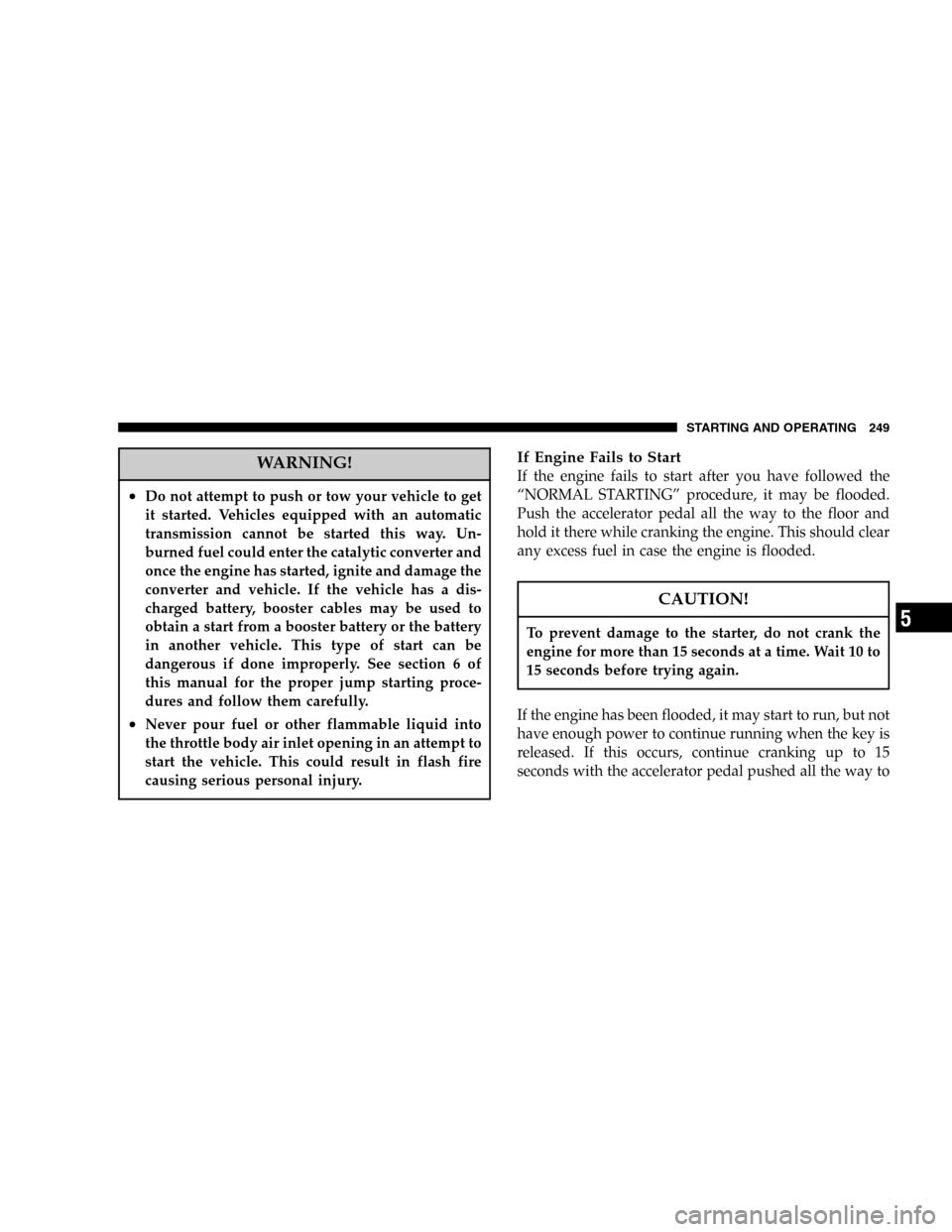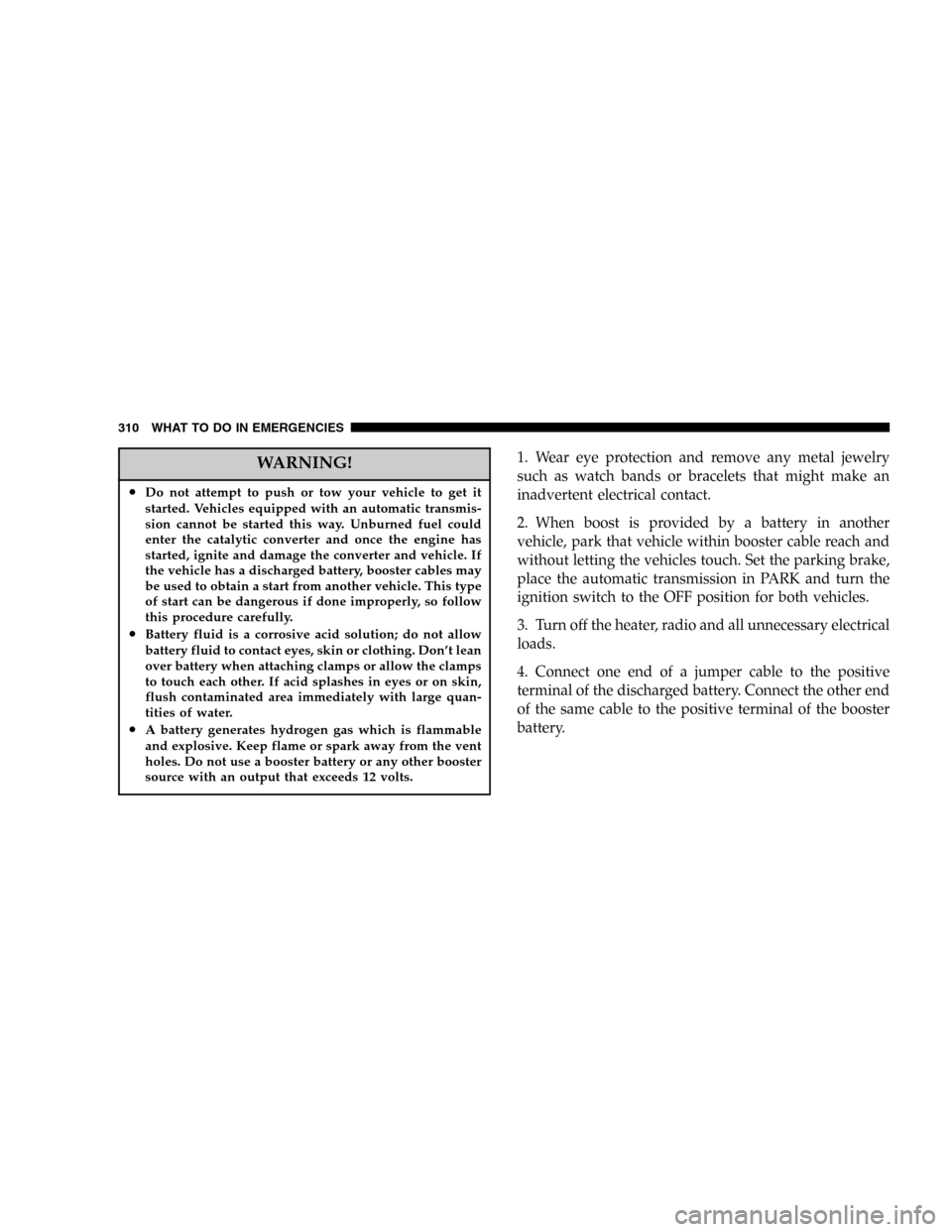Page 249 of 420

WARNING!
•Do not attempt to push or tow your vehicle to get
it started. Vehicles equipped with an automatic
transmission cannot be started this way. Un-
burned fuel could enter the catalytic converter and
once the engine has started, ignite and damage the
converter and vehicle. If the vehicle has a dis-
charged battery, booster cables may be used to
obtain a start from a booster battery or the battery
in another vehicle. This type of start can be
dangerous if done improperly. See section 6 of
this manual for the proper jump starting proce-
dures and follow them carefully.
•Never pour fuel or other flammable liquid into
the throttle body air inlet opening in an attempt to
start the vehicle. This could result in flash fire
causing serious personal injury.
If Engine Fails to Start
If the engine fails to start after you have followed the
“NORMAL STARTING”procedure, it may be flooded.
Push the accelerator pedal all the way to the floor and
hold it there while cranking the engine. This should clear
any excess fuel in case the engine is flooded.
CAUTION!
To prevent damage to the starter, do not crank the
engine for more than 15 seconds at a time. Wait 10 to
15 seconds before trying again.
If the engine has been flooded, it may start to run, but not
have enough power to continue running when the key is
released. If this occurs, continue cranking up to 15
seconds with the accelerator pedal pushed all the way to
STARTING AND OPERATING 249
5
Page 310 of 420

WARNING!
•Do not attempt to push or tow your vehicle to get it
started. Vehicles equipped with an automatic transmis-
sion cannot be started this way. Unburned fuel could
enter the catalytic converter and once the engine has
started, ignite and damage the converter and vehicle. If
the vehicle has a discharged battery, booster cables may
be used to obtain a start from another vehicle. This type
of start can be dangerous if done improperly, so follow
this procedure carefully.
•Battery fluid is a corrosive acid solution; do not allow
battery fluid to contact eyes, skin or clothing. Don’t lean
over battery when attaching clamps or allow the clamps
to touch each other. If acid splashes in eyes or on skin,
flush contaminated area immediately with large quan-
tities of water.
•A battery generates hydrogen gas which is flammable
and explosive. Keep flame or spark away from the vent
holes. Do not use a booster battery or any other booster
source with an output that exceeds 12 volts.
1. Wear eye protection and remove any metal jewelry
such as watch bands or bracelets that might make an
inadvertent electrical contact.
2. When boost is provided by a battery in another
vehicle, park that vehicle within booster cable reach and
without letting the vehicles touch. Set the parking brake,
place the automatic transmission in PARK and turn the
ignition switch to the OFF position for both vehicles.
3. Turn off the heater, radio and all unnecessary electrical
loads.
4. Connect one end of a jumper cable to the positive
terminal of the discharged battery. Connect the other end
of the same cable to the positive terminal of the booster
battery.
310 WHAT TO DO IN EMERGENCIES
Page 405 of 420

Selection Of Lubricant................349,370
Shifting............................. 253
Special Additives...................... 352
Automatic Transmission................... 349
Adding Fluid......................... 350
Fluid and Filter Changes................. 351
Fluid Change......................... 351
Fluid Level Check...................... 350
Fluid Type........................... 349
Autostick........................135,253,254
Ball Joints............................. 337
Battery............................... 333
Gas Caution.......................... 334
Jump Starting......................... 309
Keyless Transmitter Replacement............ 24
Bearings.............................. 354
Belts, Drive............................ 330
Body Mechanism Lubrication............... 338B-Pillar Location........................ 268
Brake, Parking.......................... 256
Brake System........................258,346
Anti-Lock........................... 258
Fluid Check.......................347,370
Hoses.............................. 346
Warning Light........................ 167
Brakes.............................258,346
Brake/Transmission Interlock............... 251
Break-In Recommendations, New Vehicle........ 67
Bulb Replacement....................... 364
Bulbs, Light............................ 363
Calibration, Compass..................... 180
Capacities, Fluid........................ 368
Caps, Filler
Fuel................................ 290
Oil (Engine).......................328,329
Radiator (Coolant Pressure)............... 343
INDEX 405
10